
If you focus on your physical fitness, it might be a good idea to include your mental wellbeing in the journey as well.
With the semester of graduate school behind me, I’m finally prioritizing some essential self-care and enrolled in a nearby yoga studio. My consistency in practice waned amidst global events and the extra time crunch of grad school combined with full-time work. However, with everything I’m juggling, carving out time for self-care has become even more crucial.
Although my yoga sessions were less frequent over the last few months, as I only managed to attend outdoor classes once a week, I did invest in developing another aspect. I began to take mindfulness and meditation much more seriously over the past year. I’ve explored everything from spending quiet time alone to doing a Calm trial and attending meditation sessions on Clubhouse. Initially, it felt like a challenging journey, but now that I’ve built stronger habits around meditation, I’m discovering it significantly easier to be mentally present when I unroll my mat for yoga.
Mindful awareness is often the most overlooked aspect of yoga for some practitioners. Even if you are physically on the mat and performing the movements, your thoughts could be elsewhere, racing at lightning speed. The greater your stress and responsibilities, the trickier it becomes to detach from it all and simply exist in the moment with full mental presence.
Synchronizing your breath is just as vital in yoga as mastering the postures.
In my early years of practice, I consistently undervalued the significance of breathwork. I would attempt to manage my breathing while keeping pace, but for newcomers, balancing everything simultaneously can be quite difficult. Even though I was very earnest about learning proper alignment and achieving smooth transitions, I overlooked mastering the breath.
Reflecting on my past, I can now clearly identify the shortcoming in my earlier approach. The breath is indeed an integral aspect of yoga. It’s a challenge to breathe mindfully while striving for strength and flexibility, but truly moving in harmony with the breath, as teachers always recommend, compels you to be more present. It becomes captivating and absorbing. It demands intense focus to synchronize your movements with each breath.
Even if it appears daunting, as it was for me initially, persist in your efforts. As the poses grow more familiar and slightly easier, breathing through them starts to feel more natural. The act of aligning movement and breath transforms each pose into a significant experience. You’re preparing for each instant with every inhalation and exhalation. This interaction amplifies the sensations and stretches of each pose. When you’re immersed in those feelings, it becomes far easier to maintain mindful presence during your class.
In moments of stillness, counting breaths offers immense grounding.
It’s a straightforward practice—count the seconds that pass during your inhalations and exhalations. This is a frequent suggestion for initiating a meditation practice, as it engages your mind in a way that relates to what you’re doing physically. Often, when your thoughts are rampant, the mental chatter bears little connection to your physical actions. For instance, when driving, you aren’t focused on the act of driving every second you’re in the car.
If you struggle to quiet your mind, counting each breath can serve as an excellent grounding strategy. I used to find it challenging to silence my thoughts. That simple, instinctual act of counting numbers made it substantially easier for me to transition to genuine meditation.
Moreover, if you find yourself in the winding-down phase of a yoga class, intentionally elongating your exhalations can be beneficial. This technique has been shown to reduce your heart rate. If you’re interested in a bit of scientific insight, prolonging your exhalations relative to your inhalations activates the parasympathetic nerve, promoting relaxation. If you’re transitioning to shavasana, it’s a wonderful approach to slow down.
Visualization techniques can assist in calming turbulent thoughts.
If your mind refuses to quiet down, try directing it toward something more tranquil. Visualizing scenarios and trying to perceive them with your mind’s eye requires considerable mental effort.
I began experimenting with visualization during shavasana when I practiced at a studio that frequently played music. I found it quite challenging to halt my thoughts, so I would strive to keep my mind calm and visualize elements that resonated with the music. At times, I envisioned myself floating when the music had a nautical vibe. Other times, I simply imagined colors moving abstractly.
Visualization is extraordinarily subjective and variable. If it proves helpful, you could try visualizing yourself